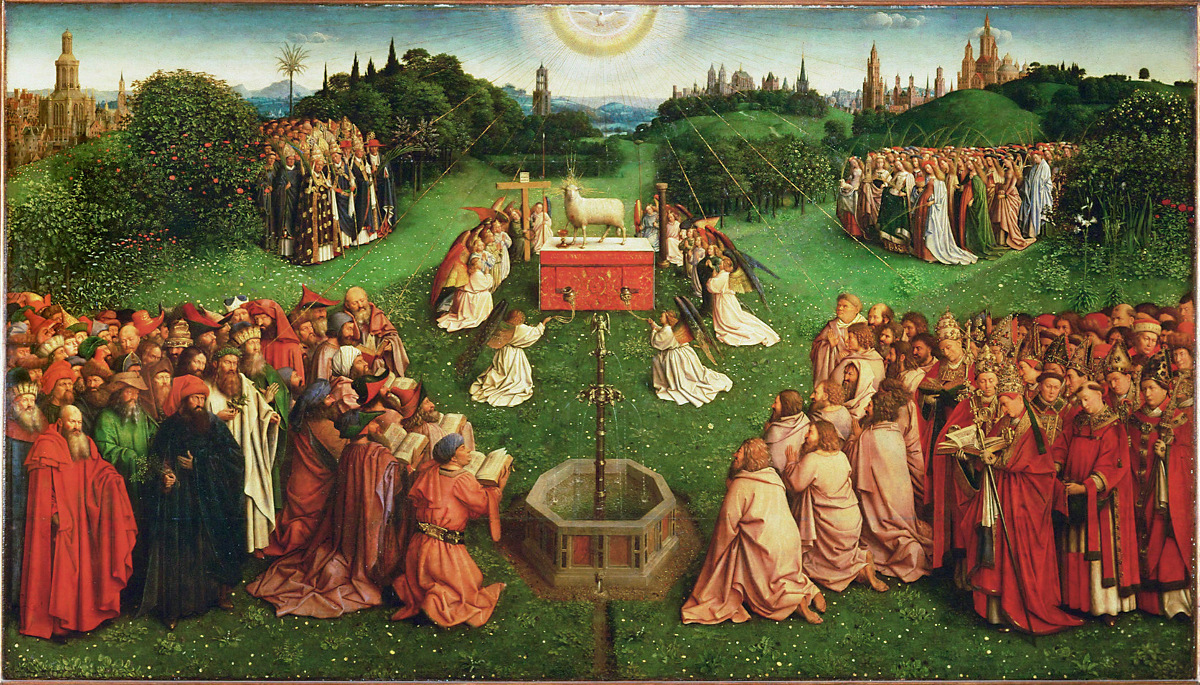The Lamb's Supper: The Bible and the Mass
Lesson Four: Fulfilled in Your Hearing: The Liturgy of the Word

Lesson Objectives
- To understand Scripture as the living Word of God.
- To understand the place of Scripture at the center of the liturgy.
- To see Scripture as an encounter with Christ, the living Word of God.
- To see how the Liturgy of the Word prepares us for the Liturgy of the Eucharist.
III. The Word in the Liturgy of Israel
A. The Place of Scripture
In joining their own Scriptures to that of the Old Testament in the celebration of the Eucharistic sacrifice, the early Church was continuing a tradition begun by Israel.
Since Scripture was believed to be the speech of God delivered through human instruments, it had an important place in the Israelites' liturgy. Indeed, it held a place very similar to the place it occupies in our own Liturgy of the Word.
When Moses received the Law from God, he recited everything God had told him to the people. They responded "with one voice" that they would do everything God had told them (see Exodus 24:3). Then they offered sacrifice to God, and, in effect, were given communion in the "blood of the covenant" (see Exodus 24:4-8).
In just the same way, after we hear the Word of God in our Liturgy of the Word, we profess our faith "with one voice" in the words of the Creed. Then the priest offers the Eucharist, and we have communion in the "blood of the covenant" (see Mark 14:24), which is made present to us on the altar.
Much later in the history of Israel, we see a similar liturgical use of God's Word in the reforms of King Josiah.
A priest had found the Book of the Law (the first five books of the Old Testament) that had been hidden during the reign of a wicked king (see 2 Chronicles 34:14-18).
The good King Josiah had the book read to the assembly of people, and vowed on behalf of the people to keep all the commandments in it (see 2 Chronicles 34:29-32). And, following the reading of the Word and the profession of faith, again we see a liturgical sacrifice (see 2 Chronicles 35:1-19).
B. The Liturgy of the Synagogue
When Jerusalem was destroyed and the people carried off to Babylon (see 2 Kings 25:8-12), the people could no longer worship at the Temple. Instead, they formed local congregations.
These "synagogues" (from a Greek word meaning "assemblies") continued after the people were allowed to return to Jerusalem (see Ezra 1:1-4) as convenient places of meeting on the Sabbath.
When the exiles returned from Babylon and reestablished the worship of the true God in Jerusalem, the reading of Scripture formed the heart of their worship (see Nehemiah 8).
And this remained true in Jesus' time. We can see a good picture of that synagogue liturgy early in Luke's Gospel, where Jesus is invited to read the lesson of the day in the synagogue in Nazareth (see Luke 4:16-22).
Jesus reads the lesson from Isaiah, then interprets it in a sermon (see Luke 4:23-27) - just as today we hear readings and then an sermon interpreting the readings in our Liturgy of the Word.
Other Lessons
- Lesson One: A Biblical Introduction to the Mass
- 1. To understand basic Catholic beliefs about the relationship between the Bible and the Liturgy.
- To understand the biblical basis for the Mass.
- To understand how in the Mass, the written text of the Bible becomes Living Word.
- Lesson Two: Given for You - The Old Testament Story of Sacrifice
- To understand the biblical background to the Penitential Rite and the Gloria in the Mass.
- To understand how God is worshipped in the Old Testament.
- To understand the biblical notion of sacrifice as it is presented in the Old Testament.
- Lesson Three: One Sacrifice for All Time
- To understand the death of Jesus Christ on the cross as a sacrifice.
- To see the parallels between the Old Testament sacrifices and the sacrifice of Christ on the cross.
- To understand how that sacrifice is re-presented to us in the Mass.
- Lesson Five: Heaven On Earth: The Liturgy of the Eucharist
- To understand the deep biblical foundations for the Liturgy of the Eucharist.
- To see how the Book of Revelation describes the liturgy of heaven.
- To understand how the Mass we celebrate on earth is a participation in the liturgy of heaven.
- Lesson Six: Memory and Presence: Communion as the Coming of Christ
- To understand the deep biblical foundations of Jesus’ command that the Eucharist be celebrated “in memory of Me.”
- To see how Scripture portrays Jesus as the Passover Lamb and how that portrayal is reflected in the Mass.
- To understand the Eucharist as parousia, the “coming” of Christ, and as the “daily bread” we pray for in the Our Father.


